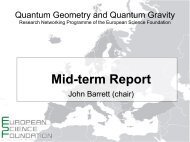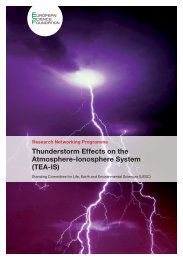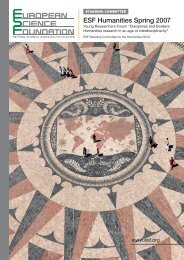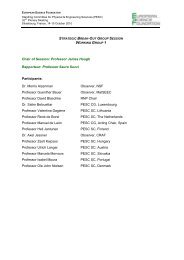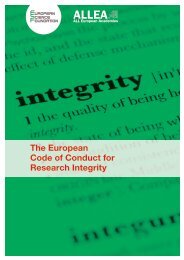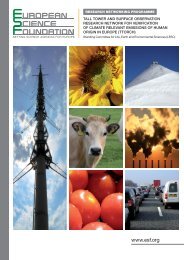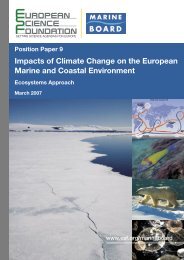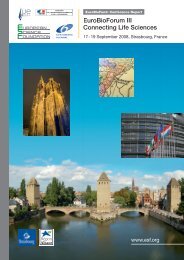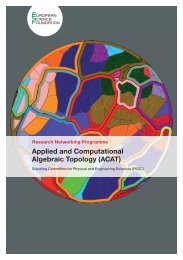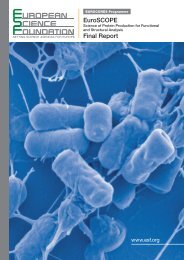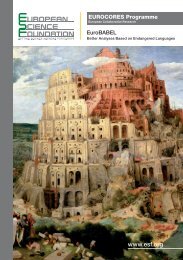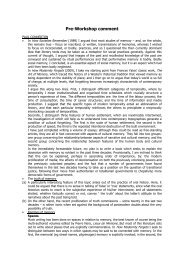European Peer Review Guide - European Science Foundation
European Peer Review Guide - European Science Foundation
European Peer Review Guide - European Science Foundation
You also want an ePaper? Increase the reach of your titles
YUMPU automatically turns print PDFs into web optimized ePapers that Google loves.
36<br />
<strong>European</strong> <strong>Peer</strong> <strong>Review</strong> <strong>Guide</strong><br />
4.10.3 Measure of quality and usability<br />
of the reviewers’ assessments<br />
Some of the items defining the quality and usability<br />
of the assessments made by individual/remote<br />
reviewers are:<br />
• Conflicts of interest;<br />
• Completeness;<br />
• Comprehensibility and clarity;<br />
• Appropriateness of the language used;<br />
• Fit for purpose;<br />
• Timely;<br />
• Substantiated judgments and scores.<br />
4.10.4 Evaluation<br />
Evaluation entails appropriate measures and means<br />
of supervising and scrutinising the process and its<br />
implementation by authoritative and experienced<br />
individuals or groups of individuals. This could<br />
comprise parties either internal or external to the<br />
organisation or a mixture of the two. The term ‘evaluation’<br />
used here does not refer to ex-post evaluation<br />
of the funded research38.<br />
It is important to clearly describe to all relevant<br />
parties and at the beginning of the process the following<br />
items:<br />
• The purpose of the evaluation;<br />
• The scope of the evaluation;<br />
• The means available to conduct the evaluation;<br />
• What could be the outcome of the evaluation.<br />
4.10.5 Overall recommended measures<br />
in support of quality assurance<br />
To support quality assurance the following aspects<br />
may be considered:<br />
• Identify and mandate dedicated individuals or<br />
groups of individuals responsible for the conceptualisation<br />
and administration of quality reviews; as<br />
far as possible, ensure continuity by avoiding the<br />
use of temporary assignments and frequent staff<br />
changes. Make clear the roles and the responsibilities<br />
of the programme officers and administrators<br />
and thus demand accountability;<br />
• Ensure consistency and clarity of the published<br />
material and all other communication streams to<br />
all stakeholders;<br />
• Offer clear instructions, briefing notes and, if pos-<br />
38. Ex-post evaluation of the funded research has not been included<br />
as part of this <strong>Guide</strong>. On this topic see, for example, the Reports<br />
of the ESF Member Organisation Forum on Evaluation of Publicly<br />
Funded Research at: http://www.esf.org/activities/mo-fora/<br />
evaluation-of-publicly-funded-research.html and the ESF Member<br />
Organisation Forum on Evaluation of Funding Schemes and<br />
Research Programmes at: http://www.esf.org/activities/mo-fora/<br />
completed-mo-fora/evaluation-of-funding-schemes-and-researchprogrammes.html<br />
sible, training sessions for reviewers and panel<br />
members to ensure the coherence and consistency<br />
of their approaches;<br />
• Keep the procedure as simple as possible, increase<br />
the level of standardisation and automation<br />
whenever proven technologies and resources are<br />
available. Systematic tracking of reviewers’ quality<br />
can be very beneficial.<br />
• Conduct periodic reviews of the processes and procedures.<br />
The cycle length of the reviews – whether<br />
they are programme-based, department/unitbased<br />
or institution-based – may vary according<br />
to disciplinary or institutional needs.<br />
The survey on peer review practices has shown that<br />
the responding organisations adopt the following<br />
correcting actions in cases when the quality and<br />
usability of the assessments fall short of their standards:<br />
• The entire review may be discarded and not used<br />
according to 56% of the respondents;<br />
• The review might be returned to the reviewer for<br />
completion/additional information (according<br />
to 52% of the respondents) or for modification<br />
(according to 32%);<br />
• 40% of the responding organisations indicated<br />
that reviewers may be tagged based on the quality<br />
and usability of their assessments39 with qualifying<br />
information that may be used for future<br />
references;<br />
• The data protection laws of each country may dictate<br />
the nature and usage of this information.<br />
4.11 Variants of funding<br />
instruments and their implication<br />
for <strong>Peer</strong> <strong>Review</strong><br />
One of the main challenges for structuring both the<br />
<strong>Guide</strong> and the supporting peer review survey has<br />
been to categorise main funding instruments common<br />
to <strong>European</strong> research funding and performing<br />
organisations and councils. The conclusion has been<br />
to treat the task of grouping of instruments along<br />
two dimensions.<br />
The first dimension considers the main typology<br />
of the funding instruments that is driven only by<br />
the nature and size of the funding opportunity; the<br />
second dimension relates to the different program-<br />
39. See <strong>European</strong> <strong>Science</strong> <strong>Foundation</strong> (2010b), ESF Survey<br />
Analysis Report on <strong>Peer</strong> <strong>Review</strong> Practices, in particular Section 3.2,<br />
§3.2.2, Question 22: “What concrete actions can result from the<br />
evaluation of a review’s quality and usability by your organisation?”<br />
(Table 3.7).



